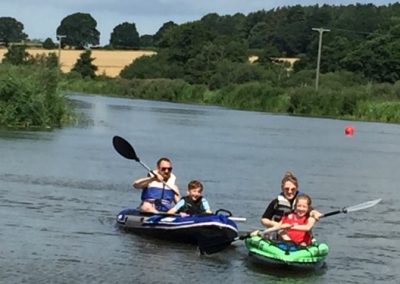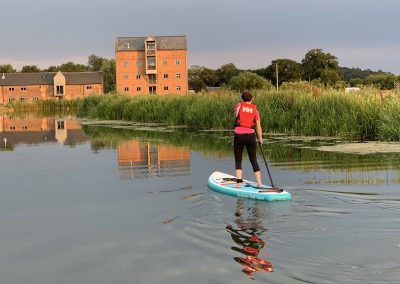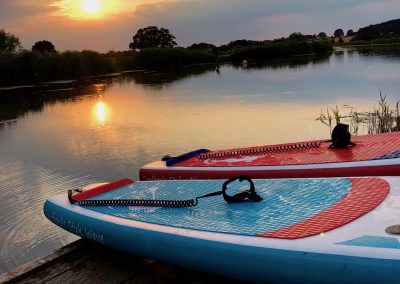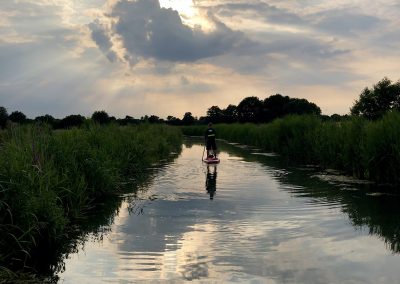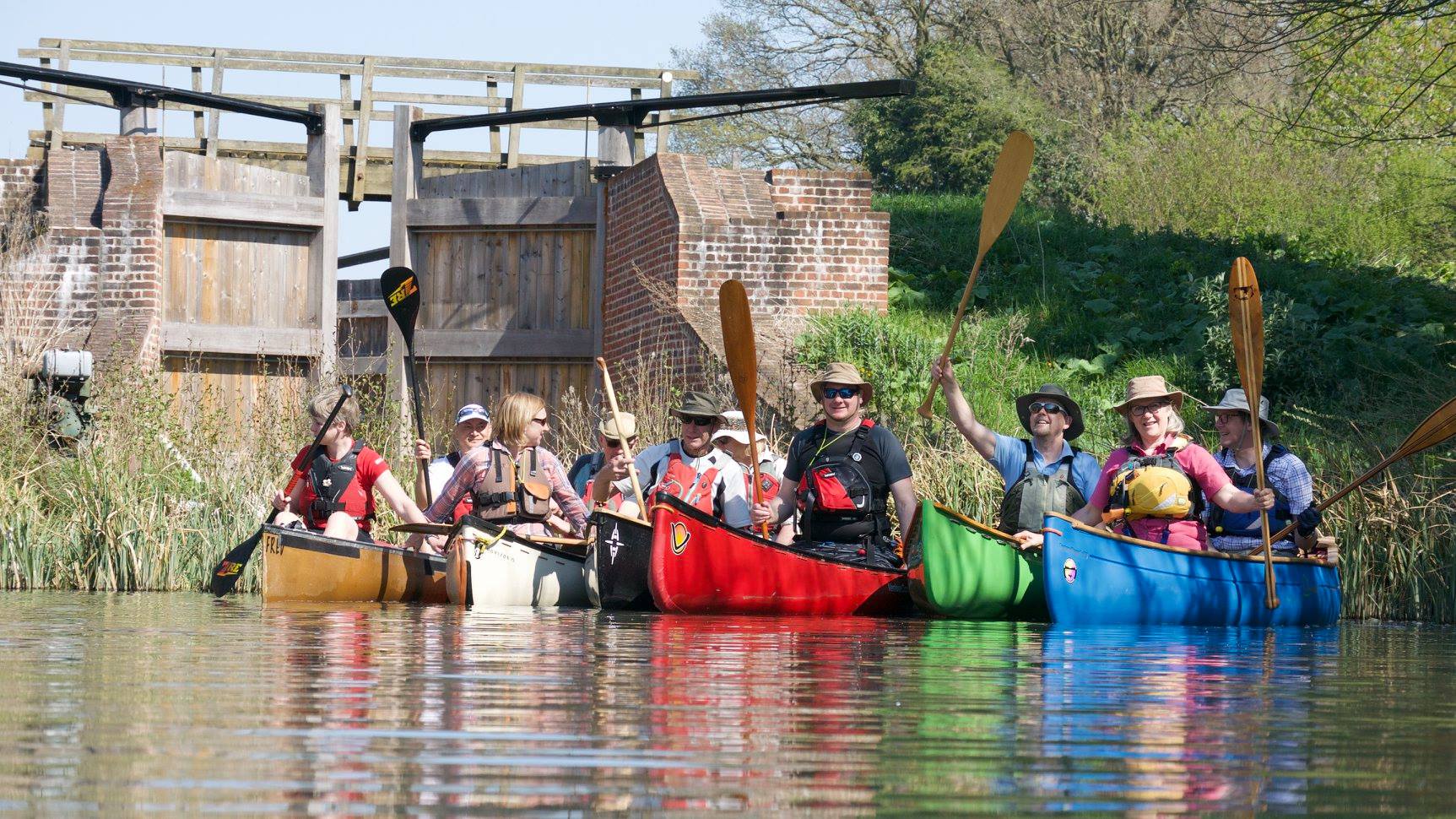
Paddlesports
The restored stretches of the North Walsham and Dilham Canal are popular for canoeing, kayaking and stand up paddleboarding and are frequented by casual paddlers as well as the occasional canoe club or organised group. Close to the Norfolk Broads, but not currently navigable as part of the main powerboating network, paddlers on the North Walsham and Dilham Canal regularly comment on the quiet, secluded nature of the waterway.
If you want to enjoy a calmer, historic stretch of water, away from Broads boats and the hire motorboats more common elsewhere on the Broads, the North Walsham and Dilham Canal is an excellent place to paddle. Below you’ll find more information about paddlesports on the canal including kayaking, canoeing and paddleboarding. We look forward to seeing you on the water.
Please note: No HIRE boats are allowed on the tidal stretch of the canal up to Honing Lock. This statement is available to view on the entrance to the canal.
Do I need a license to paddle on the North Walsham and Dilham Canal?
No, a license is not required to paddle on the North Walsham and Dilham Canal.* Downstream of Honing Lock, however, a toll is requested by the landowner and can be paid into the metal toll box attached to the wooden jetty beside Tonnage Bridge.
Once on the River Ant, you are in the Broads Authority navigation area and a license or toll is required. If you are a member of British Canoeing, you are already licensed to canoe, kayak or stand up paddleboard on any of the Broads Authority waterways, including the main rivers and associated broads and dykes, without the need to pay a toll. If you are not a member of British Canoeing, once you join the Broads Authority waterway network you will require either a Broads Authority short visit toll or an annual toll (depending on how frequently you plan on using the waterways).
*Though a license is not required on the North Walsham and Dilham Canal, membership of the British Canoeing Union also provides you with Public and Products Liability Insurance, so paddler membership is still highly recommended.
Where can I launch canoes and kayaks?
There are multiple places where paddlers can gain access to the water, all listed below.
The North Walsham and Dilham Canal can broadly be divided into three sections; the three-mile stretch above Ebridge Mill – placid, easy to navigate, with two working locks (one currently still in a state of repair) and set in open countryside with a footpath or permissive path alongside – and the stretch below Ebridge Mill, where the water channel is far narrower, the banks are often lined with trees, locks are disused and there is a footpath alongside at times (but no clear towpath). It is not until you reach Dilham that the canal is really navigable again by canoe.
- Not Currently Available: Bacton–North Walsham Road at Royston Bridge: This section of the canal is currently undergoing maintenance and the water is not at a navigable level (dry in many places). Canoeing and kayaking may be possible from 2022 onwards.
- Spa Common Bridge: Potential launching point but access is very poor. Parking in this area is relatively sparse but there is some on-road space a hundred metres or so from the canal on the west side of the bridge and further into Spa Common. From here, you’ll need to walk down the road to the permissive footpath which starts next to the bridge. The bank here is steep in places and there is no landing stage or launching platform. Great care should therefore be taken and paddlers should beware that, though access is possible, there is no purpose-built launching access. From here, paddlers can only travel downstream owing to restoration work upstream that means the canal bed is currently dry.
- Ebridge Mill: Perhaps the most convenient launch point on the whole canal is in the mill pond opposite Ebridge Mill (postcode for SatNavs: NR28 9QG). There is a grassy area for parking next to Ebridge Mill lock. By crossing the lock (either on the road or by the footbridge provided), you’ll find a wooden launching stage erected by the model boating club that the public can use. Paddlers on this stretch of water – currently up to one mile upstream of Ebridge Mill – are navigating the restored stretch of the canal, which is easy going, very accessible and has good views on either side. It is free to launch canoes at Ebridge Mill, though contributions to the Trust are most appreciated.
- Canal Camping (private; for campers only): The wilder, narrower stretch of water around Dilham makes for atmospheric canoe and kayak paddling, with a campsite beside the water where Canadian canoes are available to hire for campers. Canal Camping (078114 40280) is open in the summer months only and, outside of these dates, access is private. There is, however, a canoe launching spot on the opposite bank nearby (see below). Be aware that Honing Lock, just downstream of the campsite, is currently a weir/waterfall and you will need to portage around. The flow of the water throughout the North Walsham and Dilham Canal is very slow, so hazards do not rush up on you (you can hear the weir at Honing Lock before you reach it).
- Honing Lock: Honing Lock is the lowermost lock on the North Walsham and Dilham Canal and is in a state of disuse. There is space for about three cars 20 metres from the canal (postcode for SatNavs: NR28 9PJ). To paddle downstream, you can very easily launch beside the footbridge that crosses the small diversion channel, taking water around the lock. To paddle upstream you will need to cross the channel, cross the lock and launch from the bank just upstream of the weir. Access is far muddier and more hazardous here, so great care should be taken.
- Tonnage Bridge: A mile and a half further downstream is Tonnage Bridge, which is another popular launch point. There is a purpose-built launch stage with a small drop to the water. There is a charge to launch your own canoe here (£5 and £5 for all-day parking) and they also hire canoes and stand up paddleboards from the hall (canoes from £40). More information can be found on the Dilham Hall website, with regular updates on their Facebook page.
- Wayford Bridge: The lowermost launching point along the North Walsham and Dilham Canal is at the mouth of the canal where it joins the River Ant/Dilham Dyke. The pub at Wayford Bridge (01692 582414; postcode for SatNavs: NR12 9LL) allows canoes and kayaks to launch with permission. Simply drop in and check with the landlord first, have a paddle and then come back for a pint or some food. You are on the River Ant here, but head upstream and you can join the North Walsham and Dilham Canal on the right hand side (about 200 metres upstream of the pub). If the Wayford Bridge Inn is too busy then Smallburgh Staithe is on the other side of the road – a donation of £3 is requested for launching at Smallburgh Staithe. Car parking at Smallburgh Staithe is free.
Where can I hire canoes on the North Walsham and Dilham Canal?
There are three places to hire canoes along the North Walsham and Dilham Canal, all in the lower reaches of the canal. Campers at Canal Camping can hire canoes directly from the campsite in summer (see launching point 4 above). A little further downstream, canoes are available for hire at Tonnage Bridge (£30 SUP hire and £30–£40 canoe hire), with ready information on Facebook (07768 838957).
Where is the nearest canoe or kayak club?
There is no local canoe club to the North Walsham and Dilham Canal. The nearest canoe clubs are in Norwich, where you will find Norwich Canoe Club and Eagle Canoe Club. Both clubs welcome all paddlers, though, the former has a focus on competitive paddling across canoe and kayak classes, while the latter is more focused on recreational paddling and canoe touring.
Stand Up Paddleboarding (SUPing)
Stand up paddle boards have grown in popularity in recent years and can launch from all of the same access points as canoes listed above. The lower reaches of the canal, downstream of Ebridge Mill, are not currently restored to a fully navigable state for larger boats, making this area all the more enchanting to paddle. It does mean, however, stand up paddleboarders are more likely to come across obstacles such as low-hanging trees and narrow stretches of channel, particularly between Ebridge Mill and Honing Lock, so if you’re unsteady on your feet beware. The most popular stretch of the North Walsham and Dilham Canal for stand up paddleboarders is upstream of Ebridge Mill, with paddlers frequently launching from the wooden stage opposite Ebridge Mill (see launch point 3 above).
Paddlesports events
There are no specific paddlesports events planned on the North Walsham and Dilham Canal at this time. This page will be updated with future events or visit our dedicated Events page for other activities. Though there are no organised events, we welcome paddlers and clubs at any time of the year.
Where can I find out more?
On a national level, the British Canoeing Union website is a treasure trove of paddling information and covers everything you need to know about learning to canoe or kayak, finding tuition with qualified coaches and access waterways across the UK.
In Norfolk, the Broads Authority website has many pages dedicated to canoeing and kayaking, including illustrated maps of suggested routes. See the Wayford Bridge Canoe Trails map for coverage of the North Walsham and Dilham Canal below Honing.
Norfolk Broads Canoe and Kayak Guide by Steve Maloney (Pesda Press; 2020) is an excellent guide for paddlers who wish to explore the Broads. It covers all launching points on the Broads in detail. The book only covers the Broads Authority official area and, consequently, there’s very little mention of the North Walsham and Dilham Canal. However, the lower reaches of the canal up until Honing are covered in this guide.
Other useful links:
- Go Paddling! (The British Canoeing Union Magazine)
- BCU Eastern England Facebook Page
- East Anglian Kayaking & Canoeing Facebook Group
- The Canal & River Trust Canoeing & Kayaking Page
- The Open Canoe Association
Paddlesports are undertaken at your own risk
The North Walsham and Dilham Canal Trust have done their utmost to provide reliable information on this page, however, all paddlers access the canal at their own risk and all watersports and paddlesports activities on the canal are undertaken at your own risk. All paddlesports have inherent risks, including the risk of death or serious injury. We strongly recommend that all paddlers wear lifejackets or buoyancy aids when on or near the water, have public liability insurance (included in membership of the British Canoeing Union) and read carefully all safety advice issued by the British Canoeing Union before paddling.

